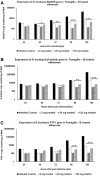Molecular characterization of Nosema bombycis methionine aminopeptidase 2 (MetAP2) gene and evaluation of anti-microsporidian activity of Fumagilin-B in silkworm Bombyx mori
- PMID: 30175023
- PMCID: PMC6108961
- DOI: 10.1007/s13205-018-1411-z
Molecular characterization of Nosema bombycis methionine aminopeptidase 2 (MetAP2) gene and evaluation of anti-microsporidian activity of Fumagilin-B in silkworm Bombyx mori
Abstract
Nosema bombycis is a spore-forming parasite causing microsporidiosis in silkworm Bombyx mori. Methionine aminopeptidase 2 (MetAP2), an essential gene of N. bombycis, is a target for the anti-microsporidian drug Fumagillin, an antibiotic derived from Aspergillus fumigatus. In this study, a 1077 bp full-length cDNA of the MetAP2 gene of N. bombycis was cloned and characterized. Furthermore, the expression study of the MetAP2 gene revealed a ubiquitous expression during all the developmental stages of the silkworm B. mori. The phylogenetic analysis of the MetAP2 gene of N. bombycis revealed the MetAP2 gene sequences to be highly conserved in nature. The present study also includes the validation of the anti-microsporidian drug Fumagillin against the MetAP2 gene of N. bombycis. The findings revealed that Fumagilin-B could also suppress the N. bombycis multiplication in the silkworm B. mori, thereby proving the therapeutic role of Fumagillin against microsporidian infection. This is the first-ever report regarding the characterization of the MetAP2 gene in the Indian isolate of N. bombycis and also towards the usage of Fumagillin in the control of microsporidiosis in B. mori.
Keywords: Anti-microsporidian; Fumagillin; MetAP2; Microsporidiosis; Nosema bombycis.
Conflict of interest statement
The authors declare that they have no conflicts of interest.This article does not contain any studies with human participants or animals.
Figures





References
-
- Higes M, Nozal MJ, Alvaro A, Barrios L, Meana A. The stability and effectiveness of Fumagillin in controlling Nosema ceranae (microsporidia) infection in honey bees (Apis mellifera) under laboratory and field conditions. Apidologie. 2011;42:364–377. doi: 10.1007/s13592-011-0003-2. - DOI
LinkOut - more resources
Full Text Sources
Other Literature Sources

